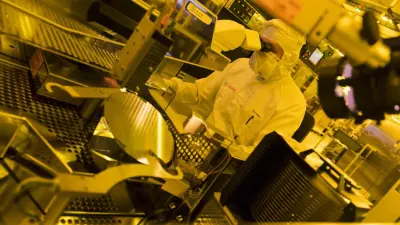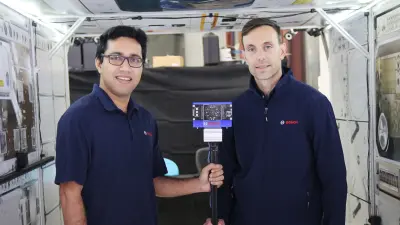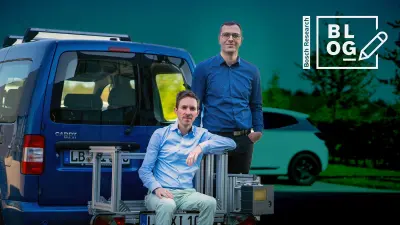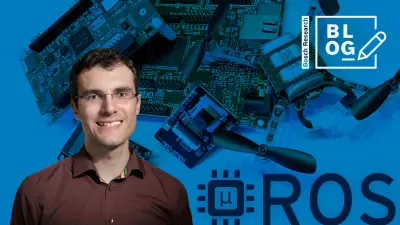Smart systems for human-machine-environment interaction
Innovations for an intelligently connected world — Bosch Research leads research into and the development of intelligent sensors, human-machine interfaces and embedded systems.

Industry 4.0, autonomous driving, care robots — connectivity and automation are the basis for our modern, connected society. Both are changing the way in which we work, communicate or manage things. The basic prerequisite for all automated technologies is that machines can find their way around quickly and without errors and act appropriately. If they “work” at the interface with humans, straightforward, reliable interaction is even more important. Seamless connections between the physical and virtual world are needed for this. The first step is to survey the environment with intelligent sensors that provide the (measurement) data for interaction. Once the data have been processed in the virtual, digital world, innovative technologies inform people via a human-machine interface (HMI), allowing them to take action themselves.
To this end, Bosch Research researches and develops not only intelligent sensors but also human-machine interfaces and so-called embedded systems. In embedded systems, tailored hardware, such as microprocessors, and software perform computations locally and autonomously to enable the systems to act autonomously.
Connecting the real and virtual worlds in a useful way
Measurement, processing, feedback and decision — this is the path that information must take from the physical to the virtual world and back again. Bosch sensors take on the role of sensory perception. They survey the physical environment and transfer this information to the virtual world. They ensure that the right data can be collected at the right time and in appropriate quality before being processed by computers. And sensors are the senses for artificial intelligence (AI) too. Whatever the type of algorithm, the quality of the sensor technology plays a decisive role in the quality of the results. Computing units built into the sensors process the data collected with the help of classic and AI algorithms. The fact that direct and local computation saves the energy and time that it would cost to move the computing operation (including data transfer) to the cloud is a particular advantage of embedded systems. For users, this extends the battery life of wireless systems such as smartphones, thus making them more convenient. At the save time, the data are highly secure as they are only processed locally. Depending on the situation, the results are made available to people via HMI technologies in order to be able to make decisions on the basis of adequate information.
From driver assistance systems and data glasses to breath analysis devices — the three hardware components sensor technology, computing unit and user interface must interact perfectly according to the particular application. Developing such systems comprising microelectronics and software for special areas of use is one of the tasks of our researchers. They also work to make the individual components for these intelligent paths more and more powerful and energy-efficient. Research into embedded AI and AI accelerators is one key area: this involves running AI algorithms efficiently in the smart sensors themselves — with maximum performance and minimum power consumption.

Futuristic technologies: from quantum sensors to retina projection
Most intelligent sensors are based on MEMS (Micro-Electro-Mechanical System) technology. Bosch is the world market leader here. Every day, the company produces around five million of these micro-sensors, e.g. for use in smartphones for measuring position or acceleration. Environmental sensors with cameras, ultrasound or radar are used for automated driving. Bosch is a global leader for these sensor technologies too.
Our researchers are already working on the next generation of sensor systems: quantum sensors. These can measure the quantum state of atoms and are thus much more sensitive than classic MEMS sensors. The aim of Bosch Research is to reduce the size of the quantum sensors, their power requirements and their costs to the level of MEMS sensors in the long term.
As a result, quantum sensors will offer potential in medical technology for example — for the diagnosis of neurological diseases such as Alzheimer's or Parkinson's disease. The high absolute accuracy and spatial resolution of our quantum magnetic field sensors will help us to diagnose the severity and spatial extent of, for example, degeneration of brain areas in a non-invasive manner. When it comes to creating an interface from the human brain to the outside world, we talk about so-called “brain-computer interfaces”. These special human-machine interfaces allow a direct connection between the brain and a computer for example. Possible applications include the control of machines by people with disabilities, user interfaces for everyday objects or video games and links to “augmented” or “virtual reality”.
A new area of research within sensor systems is “sensorless sensing”. The aim of this technology is to use existing wireless connections (e.g., WLAN) as sensors. This will result in new functions with no need for additional sensors.
In the area of HMI, Bosch Research is working on the next generation of data glasses which are so light and energy-saving that they can be worn all day. The basis for this is Bosch Light Drive technology which projects the requested information onto the human retina and offers numerous advantages compared to the approaches currently available.
Our research into intelligent sensors ultimately means that our technologies can record and process signals from the environment even better. The sensors survey the environment and process the data, provide feedback and make sound decisions. They bridge the gap between the physical and virtual world, allowing an automated and connected future. Work on HMI technologies helps to optimally integrate people into the real and digital environment, while allowing intelligent interaction with technical systems.









